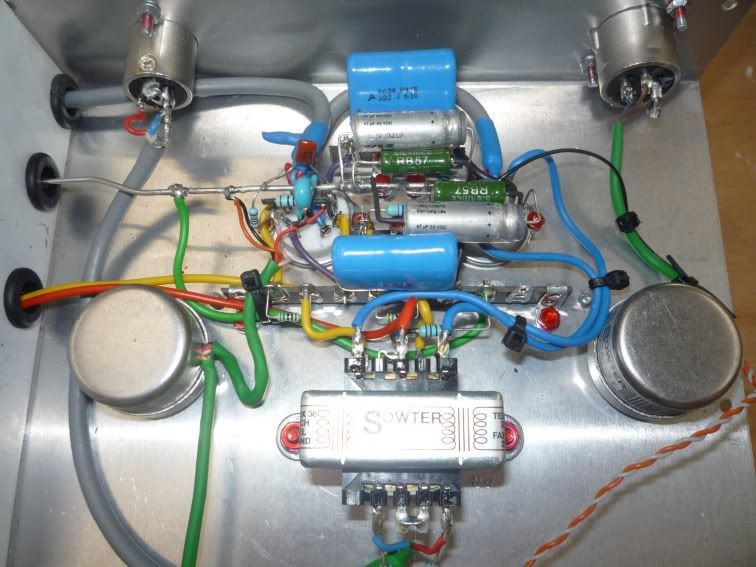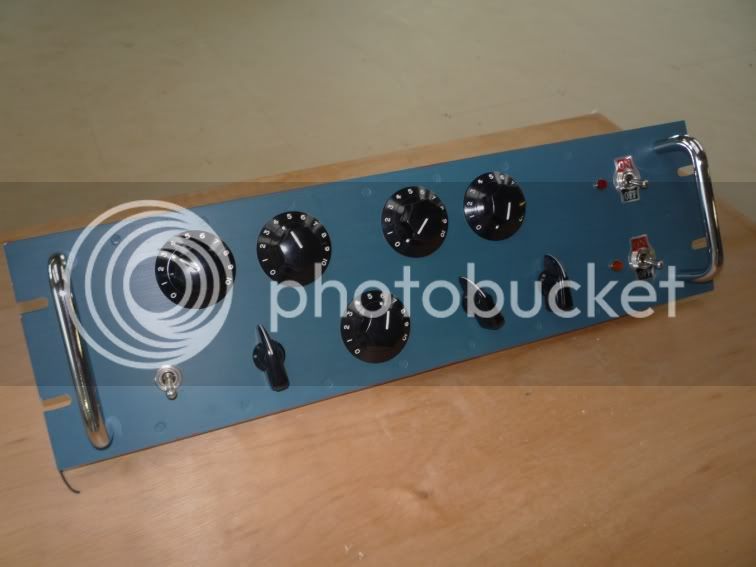Hi all,
I'm in the process of building a Pultec EQP-1A, with the layout designed and built from scratch.
I made the power supply and make-up amp first and tested it before going on to the passive section (I've already breadboarded that ok). I've used a Sowter 9330 interstage and 9530X output iron. I used a Chinese 12AX7 from RS and a 40 year old used Brimar ECC82 for the output (it had already seen 30 years use in my HIFI ! Voltage balance of the tubes was within 2%.
I wired it old school with a heavy busbar for earth and point to point without using turret boards (don't like all those wires picking up hash.
I measured +28dB into 600 ohms load before visible clipping, that's 20V! The amps output Z worked out at 57 Ohms.
The gain of the amp was 17.3 dB not including the interstage.
What astonished me was the frequency response -0.2dB at 10Hz then flat till 20kHz where it was -0.2dB it was -0.56 at 30KHz, -0.9 at 40KHz, -1.3dB at 50kHz, -3.5dB at 100kHz and -15dB at 200kHz.
I used a 1.5nF/9.1k zobel across the interstage which gave the best square wave performance and the above figures. There was no hint of instability and no need for caps across the grids of the ECC82's either.
I think the famous low-end on the Pultec must owe a lot to the amp, and the top end of the Sowter iron speaks for itself.
best
DaveP
I'm in the process of building a Pultec EQP-1A, with the layout designed and built from scratch.
I made the power supply and make-up amp first and tested it before going on to the passive section (I've already breadboarded that ok). I've used a Sowter 9330 interstage and 9530X output iron. I used a Chinese 12AX7 from RS and a 40 year old used Brimar ECC82 for the output (it had already seen 30 years use in my HIFI ! Voltage balance of the tubes was within 2%.
I wired it old school with a heavy busbar for earth and point to point without using turret boards (don't like all those wires picking up hash.
I measured +28dB into 600 ohms load before visible clipping, that's 20V! The amps output Z worked out at 57 Ohms.
The gain of the amp was 17.3 dB not including the interstage.
What astonished me was the frequency response -0.2dB at 10Hz then flat till 20kHz where it was -0.2dB it was -0.56 at 30KHz, -0.9 at 40KHz, -1.3dB at 50kHz, -3.5dB at 100kHz and -15dB at 200kHz.
I used a 1.5nF/9.1k zobel across the interstage which gave the best square wave performance and the above figures. There was no hint of instability and no need for caps across the grids of the ECC82's either.
I think the famous low-end on the Pultec must owe a lot to the amp, and the top end of the Sowter iron speaks for itself.
best
DaveP























![Soldering Iron Kit, 120W LED Digital Advanced Solder Iron Soldering Gun kit, 110V Welding Tools, Smart Temperature Control [356℉-932℉], Extra 5pcs Tips, Auto Sleep, Temp Calibration, Orange](https://m.media-amazon.com/images/I/51sFKu9SdeL._SL500_.jpg)
























